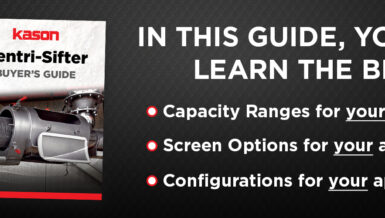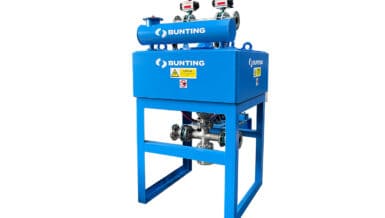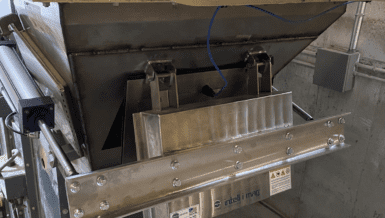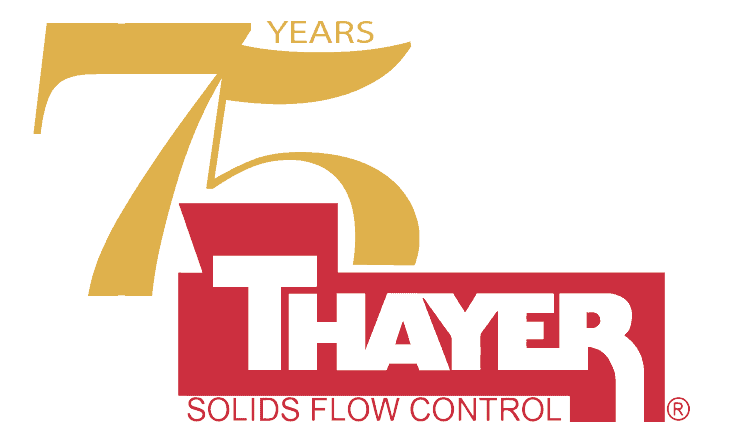Sizing
Sizing is the segregation of a variety of solid particles into separate groups containing comparable sizes. Depending on the type and size of the machine, some separators can produce up to five (5) fractions simultaneously.
Various food and chemical products are sized using vibratory round separators. Most sizing applications will be covered with lead angles from 30- to 60-degrees. Typically, sizing requires that the material reside on the screen as much as possible. So, creating an efficient spiral and increasing the residence time will provide cleaner, efficient cuts and maximize throughput.
However, there are dedusting applications that a much lower lead angle (0-10-degrees) would be required. A product like dog food has a low percentage of fines and a high volume of overs. The separator needs to remove the fines (dust) and move the good material (dog food) off the screen quickly to handle the higher feed volume. The lower lead angle is ideal for an application with these requirements.

Scalping
Scalping is the removal of a small quantity of undesirable oversize particles in a high-throughput process. Typically, the material needs to be held on the screen longer to ensure all the good material passes through and is not discharged with the coarse material. When the application has minimal oversize material, a higher lead angle (70-90 degrees) can be used if the oversize doesn’t need to be discharged. But if the oversize material is significant, then the lead angle should be a little lower (40-60 degrees) in order to allow the material to discharge.
With most scalping applications, to account for the high volume of fine material going through the screen and exiting the machine, the bottom frame is modified into what is termed a “scalping frame” which provides a steep-sloped discharge to facilitate the material exiting the separator. So, in addition to the higher lead angle, greater horizontal and vertical amplitudes are required due to the added weight of the scalping frame.
Many powdered food and drinks are typical scalping applications that will utilize a higher lead angle to hold the material on the screen longer than other processes.

Gravity Filtering
Gravity Filtering, also called Product Recovery, is the separation of oversize solids from all types of slurries or dewatering solid/liquid mixtures. The objective is to separate the liquid from the solids to reclaim any usable solids or clarifying liquids, either of which having further economic value.
A typical application that may use gravity filtering would be fruit juices or other types of food products. Consider an orange juice processing facility. The process would require the removal of various solids (peels and pulp) from the end-product (juice) prior to the final stages of processing. Typical lead angles for such an application, as well as most wet applications, would be between 40- and 60-degrees.

Wastewater Clean-up
Wastewater Clean-Up, also called Water Pollution Control, is the efficient recovery of usable solids from a waste stream or the cleaning of a water stream for the purpose of re-use.
Most if not all food processing plants will have a waste stream of some sort that needs cleaning. Canneries, for example, will need to clean the fruits and vegetables before final processing. This wash water, which would typically have large percentage of solids in it, will either be discarded or reused. If the intent is to dispose of the water, the water cannot simply be sent to the sewers. There would be environmental concerns and government consequences. The solids that are in the water will need to be removed prior to being discarded. Similarly, if the water is to be reused, it must first be cleaned. That is why most food processors utilize vibratory separators to clean their waste streams. And as with most wet applications, a typical lead angle for wastewater clean-up applications will fall between 40- and 60-degrees.

Even if two materials are similar in nature does not mean the exact parameter settings on the separator will be used for both materials. Take sugar and salt for example. Both can be processed in granulated form and have similar attributes, but that doesn’t mean that their separator settings will be identical. Even the same material from different processors could potentially use different settings because characteristics of the materials could be slightly different which could make the material react differently on the screen. Each application will have its own optimal settings.
Because the same or similar products can still be so different, before purchasing any vibratory separation equipment, the best practice is to have the manufacturer perform testing on your material to make certain the separation equipment is feasible as well as to determine the optimal settings on the separator. This will assure you that you are choosing the correct equipment and present you the settings that will deliver the maximum efficiency and throughput for the material.















































